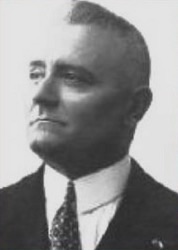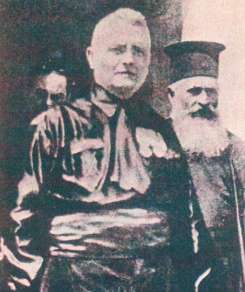Cesare Mori facts for kids
Quick facts for kids
Cesare Mori
|
|
|---|---|
 |
|
| Member of the Italian Senate | |
| In office 10 January 1928 – 5 July 1942 |
|
| Monarch | Victor Emmanuel III |
| Prefect of Palermo | |
| In office 1 November 1925 – 1 June 1929 |
|
| Prefect of Trapani | |
| In office 2 June 1924 – 12 October 1925 |
|
| Prefect of Bologna | |
| In office 8 February 1921 – 20 August 1922 |
|
| Police commissioner of Castelvetrano | |
| In office 1909 – January 1915 |
|
| Personal details | |
| Born | 22 December 1871 Pavia, Kingdom of Italy |
| Died | 5 July 1942 (aged 70) Udine, Friuli, Kingdom of Italy |
| Political party | National Fascist Party |
| Spouses |
Angelina Salvi
(m. 1897–1942) |
| Alma mater | University of Palermo (Hd) |
| Profession | Soldier, police officer, politician |
| Nickname | "The Iron Prefect" |
| Military service | |
| Allegiance | |
| Branch/service | |
| Years of service | 1895–1898 |
| Rank | Soldier |
| Battles/wars | None |
Cesare Mori (born December 22, 1871 – died July 5, 1942) was an important Italian official. He worked as a Prefect, which is like a high-ranking government representative in a region. Mori became famous as the "Iron Prefect" (Prefetto di Ferro). He earned this nickname because he was very tough in his fight against the Sicilian Mafia in the late 1920s.
Mori believed in the Italian fascism movement and its leader, Benito Mussolini. He thought they were very effective. He is known for being the first person to seriously weaken the Mafia's power in Italy. A movie called Il prefetto di ferro was made in 1977 about his efforts against the Mafia in Sicily.
Contents
Early Life and Police Work
Cesare Mori was born in Pavia, a city in Lombardy, Italy. He spent his early childhood in an orphanage. When he was seven, his natural parents finally recognized him. He later studied at the Turin Military Academy. However, he left the military because he married Angelina Salvi, who did not have the money (dowry) required by military rules.
After leaving the military, Mori joined the police force. He worked in different cities, including Ravenna and Castelvetrano in Sicily. In Castelvetrano, he became known for catching a famous bandit named Paolo Grisalfi. Later, in 1915, he moved to Florence to work as a vice-quaestor, a senior police officer.
After World War I, crime in Sicily got worse. Many war veterans joined bandit groups. In 1919, Mori was sent back to Sicily to lead special police forces against these bandits. He was known for his strong and direct methods. In one famous action at Caltabellotta, he arrested over 300 people in a single night. The newspapers praised him, saying he had dealt a "lethal blow to the Mafia." But Mori knew that bandits and the Mafia were different. He believed the real Mafia bosses were harder to catch and were often hidden in high places.
In 1920, Mori returned to mainland Italy. He worked as a quaestor in Turin, Rome, and Bologna. In 1921, he became the prefect of Bologna. At this time, he was one of the few officials who stood up against the violent actions of the Fascist movement. Because of this, Mori was moved to Bari. He retired in 1922 and moved to Florence with his wife. This was when Benito Mussolini and the Fascist party took control of the government.
Appointed to Fight the Mafia in Sicily
Mori's reputation as a strong and effective leader led to his return to public service in 1924. The Minister of the Interior, Luigi Federzoni, called him back. In the same year, Mori joined the Fascist Party.
He was first appointed as the prefect of Trapani in Sicily. He worked there from June 1924 to October 1925. Then, Mussolini made him the prefect of Palermo. He was given special powers over all of Sicily. His main job was to completely get rid of the Sicilian Mafia. Mussolini sent Mori a telegram, telling him he had "carte blanche," meaning full authority. Mussolini said that if current laws got in the way, they would simply make new ones.
Mussolini's strong desire to fight the Mafia was partly because the Mafia was challenging his power in Sicily. A successful campaign against them would show his strength as the new leader. This would help him gain more control and support.
The Fight Against the Mafia
Mori started his new job in Palermo in November 1925. He stayed there until 1929. In his first two months, he arrested more than 500 people. This number grew even larger in the following years. In January 1926, he carried out his most famous operation. He took over the village of Gangi, which was a known hideout for many criminal gangs. He used police and military forces to search every house. They arrested bandits, smaller Mafia members, and other suspects who were on the run.
Mori had to gather a lot of secret information. Then, he made many arrests all at once. This stopped Mafia members from hiding. These large-scale arrests earned him the nickname "Iron Prefect."
Mori understood how the Mafia gained its power. He believed that to defeat them, the government needed to connect directly with the people. Citizens should not have to go through Mafia middlemen to get what they needed from the authorities. Mori's methods were sometimes tough, similar to the Mafia's own ways. He didn't just arrest criminals; he also tried to make them feel ashamed. He wanted to show people that the government was strong and could protect them, so they wouldn't need the Mafia. He often found proof of how the Mafia worked and took away their property and animals.
Mori's investigations also showed that some Mafia members were working with powerful people in the government and the Fascist party. This made his position more difficult. About 11,000 arrests happened during Mori's time in Palermo. This created a huge amount of paperwork for trials. This might have been one reason for his removal from the job.
Mussolini made Mori a senator in 1928. In June 1929, Mori was officially relieved of his duties as prefect. The Fascist government proudly announced that the Mafia had been defeated.
Later Years and Legacy
As a senator, Mori continued to pay close attention to what was happening in Sicily. He made sure he was always well-informed. However, he did not have much political power anymore. He wrote his life story in 1932. Five years later, he openly shared his worries about Mussolini's new friendship with Adolf Hitler. After this, he became isolated within the Fascist Party. He moved to Udine in 1941 and died there a year later. By then, he was mostly forgotten, as Italy was busy with World War II.
At the time, many people believed that Mori had completely destroyed the Mafia. The number of murders in Sicily dropped sharply in the early 1930s. Some former Mafia members, like Antonio Calderone, later said that Mori's actions had severely hurt the Mafia. Some Mafiosi escaped and moved to other countries, especially the United States. Others stayed in Sicily and either helped the police or simply kept quiet until the Fascist government ended.
When the Allies invaded Sicily in 1943 and the Fascist government fell, the Mafia started to grow strong again. Sometimes, this happened with the help or lack of attention from the Allied military government. The Allies needed local leaders to help them govern. Because of their local power and their history of being targeted by the Fascist government, some well-known Mafiosi were put in charge of towns in western Sicily.
Some writers today question how truly effective Mori's methods were against the Mafia. While his actions were strong, at least for a short time, some believe he mainly targeted smaller criminals. They say that the most powerful Mafia bosses were not really touched. This might have forced the Mafia to go underground but did not completely get rid of it.
Learn More
Autobiography
- Mori, Cesare (1933), The last struggle with the Mafia, London/New York: Putnam
See Also
 In Spanish: Cesare Mori para niños
In Spanish: Cesare Mori para niños
- Sicilian mafia during the Mussolini regime


